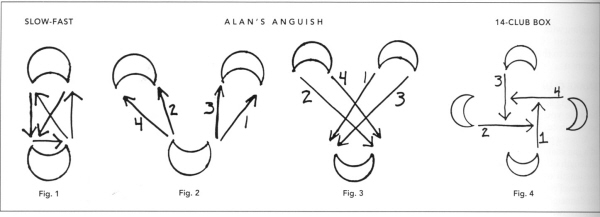 |
Page 30 Summer 1992
|
Juggler's
Workshop by
Martin Frost
In
the last couple of issues we've talked about some basic patterns and
throws in club passing, so this time we're going to delve into some
more exotic ideas. Some of these are not too difficult to put into
practice, while others may require highly experienced jugglers.
The
Slow-Fast Pattern An
uncommon pattern, though not a very hard one, is the Slow-Fast. The
name comes from the fact that one of the two passers is juggling
very slowly while the other juggles fast, in fact at twice the slow
person's speed. How is that possible? Don't they have to make equal
numbers of passes, lest one person end up with all the clubs? Yes,
they do, but they don't have to have equal numbers of selves.
The
slow juggler passes from both the right and left hands to the
partner's left hand, whereas the fast juggler passes to both hands
from the right. The slow juggler has no selves, only passes. The fast
juggler has as many selves as passes and thus makes twice as many
throws as the slow juggler. Fig. 1 shows all the throws. Basically,
the fast juggler feeds the slow juggler's two hands, and the slow
juggler responds to any club coming to a hand by passing from that
hand to the fast juggler's left hand.
The
easiest way to start this pattern is for the slow person to have one
club in each hand and the fast person to have two in each hand. The
fast person immediately starts feeding the slow person's two hands,
and the slow person just responds as necessary. (It's only
slightly more difficult to start with each person having three clubs.)
The
slow juggler should throw from in front of the body a bit when making
the left-handed diagonal passes. The fast juggler has to pass a right
diagonal behind that left-hand diagonal.
Now
consider the following two interesting variations, which can be done
separately or together. First, the fast person can feed the slow
person's two hands at random. The slow person simply responds with the
hand that a club comes to, without trying to predict which side it
will be on.
Secondly,
the slow person can catch any incoming club with either hand. That is
to say, instead of catching a club with the hand it is coming to, you
can catch it with the other hand by reaching across your body. Of
course, in doing so, you have to pass the club that was in the hand
that is reaching across. The main trick here is to allow for that
hand's momentum when making that pass, so that it goes to your
partner's left side, not way outside nor way inside.
The
interesting thing is that if the fast person suddenly throws to the
"wrong" hand, the slow person may automatically react by
reaching across the body and catcl~ng with the "correct"
hand anyway. This is a good way to learn the reaching-across catch.
Once that catch is mastered, both jugglers can have fun playing around
with these two random moves.
The
Slow-Fast pattern can also be used in a drop back line with three or
more people. The front person takes the slow role, and the rear person
feeds the front person's two hands with doubles: right-to-Ieft, right-toright.
The middle person(s) just throw normal dropbacks. If the rear person
feeds the front person with triples, there's enough time to add an
extra club (the rear person can start
with four).
Alan's
Anguish Once
you've got the Slow-Fast pattern under your belt, you might like to
try the following three-person-variation. This is called Alan's
Anguish for Alan Morgan, who suggested this pattern recently at
Stanford University.
The
basic idea is to take the selves of the fast
person in a Slow-Fast and turn them into passes to a second
slow person. The fast person thus throws no selves but feeds two slow
feedees: the right hand feeds the two hands of the right feedee and
the left hand feeds the two hands of the left feedee (from the
feeder's perspective). Since slow folks never have selves, this
leaves us with a three-person Slow-Fast with no self throws anywhere.
The
fast juggler-the feeder-simply makes the following four passes
repeatedly in this sequence, shown in Fig. 2:
(1)
right hand to right feedee's left, (2) left hand to left feedee's
left, (3) right hand to right feedee's right, and (4) left hand to
left feedee's right.
Each
feedee simply responds with a pass from any hand that gets thrown a
club. The left feedee passes only to the feeder's right hand, and the
right feedee passes only to the feeder's left hand (see Fig. 3). These
passes cross in front of the feeder, and therein lies the danger point
of this pattern-a collision caused by uneven timing of those two
crossing throws can result in two clubs crashing toward the feeder's
face. So be careful and alert.
The
above description is really pretty simple (not to imply that the
pattern is), but we haven't discussed the start. Each person has three
clubs, with two in the right hand. The first pass goes from the right
feedee's right to the feeder's left, followed quickly by the feeder's
pass from the right to the right feedee's left (pass number 1 in the
feeder's sequence listed above). Just barely after that, the left
feedee passes from the right to the feeder's right, and the feeder
responds quickly with a left to the left feedee's left (pass 2 in the
list). The feedees continue by passing when necessary to catch a club
and the feeder continues with passes ...3,4,1,2,3,4... from the
sequence listed. Note that each person always responds to a received
club by throwing back to the person the club came from, but to the
hand that didn't throw that club.
|
 |